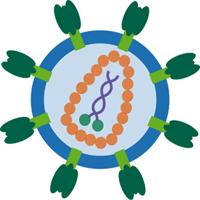 In the past 30 years, acquired immunodeficiency syndrome (AIDS) has been transformed from a devastating and poorly understood disease to a treatable and well-managed condition. Initially described as “a strange illness of unknown origin” by Jacques Leibovitch, the turning point occurred in 1983 when human immunodeficiency virus (HIV) was first recognized as the retrovirus causing the disease. Thirty years on, AIDS can be successfully managed by antiretroviral treatment, which stops disease progression, helps prevent transmission, and substantially improves the quality of life of infected individuals. To mark the progress in HIV treatment over the last 30 years, BMC Medicine, together with BMC Biology and Retrovirology, has launched a new article collection, which covers the progress made towards eradicating the virus, along with the challenges that remain.
In the past 30 years, acquired immunodeficiency syndrome (AIDS) has been transformed from a devastating and poorly understood disease to a treatable and well-managed condition. Initially described as “a strange illness of unknown origin” by Jacques Leibovitch, the turning point occurred in 1983 when human immunodeficiency virus (HIV) was first recognized as the retrovirus causing the disease. Thirty years on, AIDS can be successfully managed by antiretroviral treatment, which stops disease progression, helps prevent transmission, and substantially improves the quality of life of infected individuals. To mark the progress in HIV treatment over the last 30 years, BMC Medicine, together with BMC Biology and Retrovirology, has launched a new article collection, which covers the progress made towards eradicating the virus, along with the challenges that remain.
Despite the tremendous advances in treating HIV, there is still no cure for the disease, and there are many controversies in the field. One of the major debates is when to start antiretroviral therapy; although treating patients with various combinations of highly active drugs suppresses the virus and reduces inflammation, there are concerns over the long-term side effects of therapy, and experts are divided over whether or not treatment should be deferred until a patient’s CD4 cell count drops below a certain level. CD4 counts, which are indicative of damage to the immune system, fall over time in most patients, and those with levels below 200 are at risk of developing life-threatening illnesses.
is still no cure for the disease, and there are many controversies in the field. One of the major debates is when to start antiretroviral therapy; although treating patients with various combinations of highly active drugs suppresses the virus and reduces inflammation, there are concerns over the long-term side effects of therapy, and experts are divided over whether or not treatment should be deferred until a patient’s CD4 cell count drops below a certain level. CD4 counts, which are indicative of damage to the immune system, fall over time in most patients, and those with levels below 200 are at risk of developing life-threatening illnesses.
The controversy surrounding when to start treatment is addressed in two debate articles published this week in BMC Medicine as part of our HIV collection. Ricardo Franco and Michael Saag from the University of Alabama at Birmingham argue that treatment should be started as soon as possible in HIV-infected individuals to prevent viral replication, reduce comorbidities and to help stop the spread of infection. By contrast, Jens Lundgren and colleagues from the University of Copenhagen recommend starting therapy only when CD4 counts drop below 350 in most patients. Lundgren and colleagues highlight the potential long-term toxicity associated with lifelong antiretroviral therapy, arguing that until we have evidence from well-conducted randomized trials, the risk: benefit ratio of early therapy is unknown, so we should adopt a more cautious approach.
 The “when-to-start” question has been debated extensively at recent HIV therapy congresses. Lundgren and Saag presented their arguments at the Eleventh International Congress on Drug Therapy in HIV Infection, and at the British HIV Association (BHIVA) Spring meeting, Cal Cohen from Harvard Vanguard Medical Associates argued for an early start, whereas Caroline Sabin from University College London advocated waiting until later. Interestingly, international guidelines differ in their recommendations; in line with Lundgren and colleagues’ argument, the BHIVA guidelines advise starting therapy when CD4 counts drop below 350. On the other hand, the US guidelines suggest that therapy should be initiated as soon as possible, regardless of CD4 count.
The “when-to-start” question has been debated extensively at recent HIV therapy congresses. Lundgren and Saag presented their arguments at the Eleventh International Congress on Drug Therapy in HIV Infection, and at the British HIV Association (BHIVA) Spring meeting, Cal Cohen from Harvard Vanguard Medical Associates argued for an early start, whereas Caroline Sabin from University College London advocated waiting until later. Interestingly, international guidelines differ in their recommendations; in line with Lundgren and colleagues’ argument, the BHIVA guidelines advise starting therapy when CD4 counts drop below 350. On the other hand, the US guidelines suggest that therapy should be initiated as soon as possible, regardless of CD4 count.
Despite many years of debate, a consensus on when to start antiretroviral therapy has still not been reached. The Strategic Timing of Antiretroviral Therapy (START) trial has been designed to assess the benefits and harms of deferring treatment until CD4 counts drop below 350, and is currently recruiting participants. We eagerly await the results of this trial, and look forward to the results of further investigations with longer follow-up periods to ascertain which is the best long-term approach. Our HIV article collection remains open for submissions, and if you would like your research to be considered for publication in BMC Medicine as part of the collection, please send a pre-submission enquiry to bmcmedicineeditorial@biomedcentral.com.
Comments